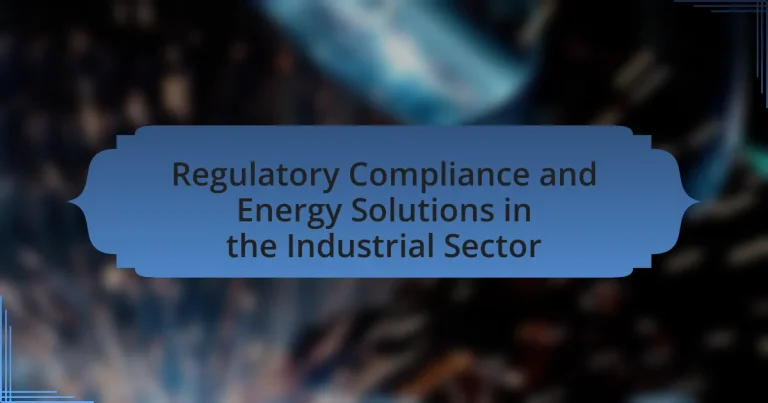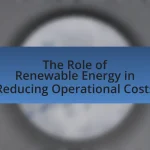Regulatory compliance in the industrial sector involves adhering to laws and guidelines that ensure safe and environmentally responsible operations, while energy solutions refer to strategies that optimize energy use and reduce costs. The article explores the interaction between regulatory compliance and energy solutions, highlighting key regulations such as the Clean Air Act and the Energy Policy Act, which drive industries to adopt energy-efficient practices. It discusses the benefits of energy management systems, renewable energy sources, and energy efficiency technologies in meeting compliance requirements, as well as the challenges industries face in achieving compliance. Additionally, the article outlines best practices for developing compliance strategies and the future trends shaping regulatory landscapes and energy solutions in the industrial sector.
What is Regulatory Compliance and Energy Solutions in the Industrial Sector?
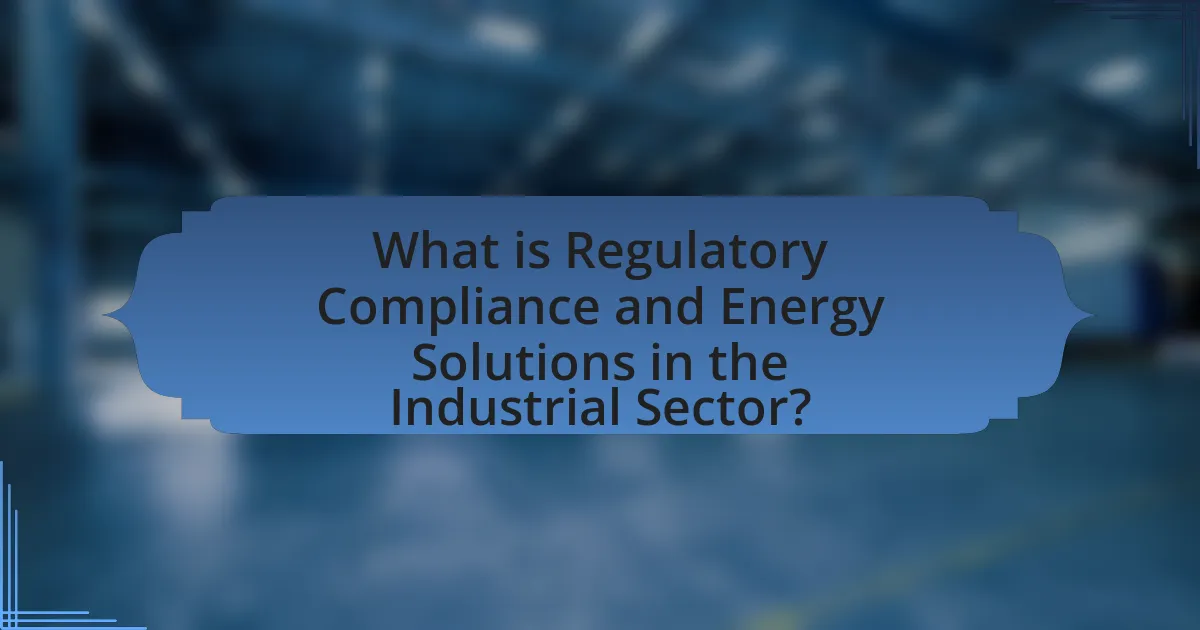
Regulatory compliance in the industrial sector refers to the adherence to laws, regulations, and guidelines set by governmental and industry bodies to ensure safe and environmentally responsible operations. Energy solutions encompass strategies and technologies implemented by industries to optimize energy use, reduce costs, and minimize environmental impact. For instance, the U.S. Environmental Protection Agency (EPA) enforces regulations that require industries to monitor emissions and implement energy-efficient practices, which can lead to significant reductions in operational costs and compliance risks.
How do regulatory compliance and energy solutions interact in the industrial sector?
Regulatory compliance and energy solutions in the industrial sector interact by ensuring that energy usage meets legal standards while promoting sustainability. Industries must adhere to regulations such as the Clean Air Act and the Energy Policy Act, which mandate reductions in emissions and improvements in energy efficiency. Compliance with these regulations often drives the adoption of energy solutions like renewable energy sources and energy-efficient technologies. For instance, companies that implement energy management systems can reduce operational costs and meet regulatory requirements simultaneously, as seen in the U.S. Department of Energy’s Better Buildings Initiative, which reports that participating organizations have achieved energy savings of up to 20%. This interaction not only helps industries avoid penalties but also enhances their reputation and competitiveness in a market increasingly focused on sustainability.
What are the key regulations affecting energy solutions in the industrial sector?
Key regulations affecting energy solutions in the industrial sector include the Energy Policy Act, the Clean Air Act, and the Energy Efficiency Improvement Act. The Energy Policy Act establishes a framework for energy conservation and promotes the use of renewable energy sources, while the Clean Air Act regulates emissions from industrial facilities to ensure air quality standards are met. The Energy Efficiency Improvement Act encourages energy-saving practices and technologies in industrial operations. These regulations collectively aim to enhance energy efficiency, reduce environmental impact, and promote sustainable practices within the industrial sector.
How do energy solutions help meet regulatory compliance?
Energy solutions help meet regulatory compliance by enabling organizations to adhere to environmental standards and energy efficiency regulations. These solutions often include technologies such as renewable energy systems, energy management software, and energy-efficient equipment, which assist in reducing greenhouse gas emissions and optimizing energy use. For instance, the implementation of energy management systems can lead to a 10-30% reduction in energy consumption, directly supporting compliance with regulations like the Energy Policy Act and the Clean Air Act. By utilizing these energy solutions, companies can not only meet legal requirements but also enhance their sustainability practices, thereby avoiding potential fines and improving their overall operational efficiency.
Why is regulatory compliance important for energy solutions in the industrial sector?
Regulatory compliance is crucial for energy solutions in the industrial sector because it ensures adherence to laws and standards that govern energy use, emissions, and safety. Compliance helps industries avoid legal penalties, which can include fines and operational shutdowns, thereby protecting their financial stability. Furthermore, meeting regulatory requirements often leads to improved energy efficiency and reduced environmental impact, aligning with global sustainability goals. For instance, the U.S. Environmental Protection Agency (EPA) enforces regulations that require industries to monitor and report their greenhouse gas emissions, promoting accountability and transparency in energy consumption.
What risks are associated with non-compliance in energy management?
Non-compliance in energy management poses significant risks, including financial penalties, legal repercussions, and reputational damage. Organizations that fail to adhere to energy regulations may incur fines that can reach millions of dollars, as evidenced by the enforcement actions taken by regulatory bodies like the Environmental Protection Agency, which has imposed penalties for violations of energy efficiency standards. Additionally, non-compliance can lead to legal actions from stakeholders or customers, further straining resources. The reputational damage can result in loss of business opportunities and decreased consumer trust, as companies increasingly prioritize sustainability and regulatory adherence in their purchasing decisions.
How can compliance enhance operational efficiency in industrial energy solutions?
Compliance enhances operational efficiency in industrial energy solutions by ensuring adherence to regulations that promote best practices and reduce waste. When organizations comply with energy efficiency standards, they often implement technologies and processes that optimize energy use, leading to lower operational costs. For instance, the U.S. Department of Energy’s Energy Efficiency and Conservation Block Grant Program has shown that compliance with energy regulations can lead to energy savings of 10-30%, which directly impacts operational efficiency. Additionally, compliance fosters a culture of continuous improvement, encouraging companies to regularly assess and enhance their energy management strategies, ultimately resulting in more sustainable and efficient operations.
What are the challenges of achieving regulatory compliance in energy solutions?
Achieving regulatory compliance in energy solutions faces several challenges, including the complexity of regulations, the rapid pace of technological change, and the need for significant investment in infrastructure. The complexity arises from the multitude of local, national, and international regulations that vary widely, making it difficult for companies to navigate compliance requirements effectively. Additionally, as energy technologies evolve, regulations often lag behind, creating gaps that can lead to non-compliance. Furthermore, substantial financial resources are required to upgrade systems and processes to meet compliance standards, which can be a barrier for many organizations. These challenges are compounded by the need for ongoing monitoring and reporting to ensure adherence to regulations, which can strain operational capacities.
What common obstacles do industries face in meeting compliance standards?
Industries commonly face several obstacles in meeting compliance standards, including complex regulations, lack of resources, and insufficient training. Complex regulations often create confusion, as industries must navigate varying requirements across jurisdictions, which can lead to unintentional non-compliance. Additionally, many organizations struggle with limited financial and human resources, making it challenging to implement necessary compliance measures effectively. Insufficient training for employees further exacerbates these issues, as a lack of understanding of compliance requirements can result in errors and oversights. These factors collectively hinder industries’ ability to achieve and maintain compliance with regulatory standards.
How can industries overcome these challenges?
Industries can overcome challenges related to regulatory compliance and energy solutions by implementing robust compliance management systems and investing in renewable energy technologies. Compliance management systems streamline adherence to regulations, reducing the risk of penalties; for instance, companies that adopt automated compliance tracking report a 30% decrease in non-compliance incidents. Additionally, investing in renewable energy sources, such as solar or wind, not only meets regulatory requirements but also lowers operational costs over time, with studies indicating that businesses utilizing renewable energy can save up to 70% on energy expenses in the long run.
How do energy solutions contribute to sustainability in the industrial sector?
Energy solutions contribute to sustainability in the industrial sector by reducing greenhouse gas emissions and enhancing energy efficiency. Implementing renewable energy sources, such as solar and wind, allows industries to decrease their reliance on fossil fuels, which are major contributors to climate change. For example, a study by the International Renewable Energy Agency (IRENA) found that transitioning to renewable energy could reduce global CO2 emissions by up to 70% by 2050. Additionally, energy-efficient technologies, such as advanced manufacturing processes and smart energy management systems, can significantly lower energy consumption, leading to cost savings and reduced environmental impact. These solutions not only help industries comply with increasingly stringent environmental regulations but also promote long-term sustainability by fostering a circular economy and resource conservation.
What role does technology play in regulatory compliance and energy solutions?
Technology plays a crucial role in regulatory compliance and energy solutions by enabling organizations to automate processes, monitor compliance in real-time, and optimize energy usage. Advanced software systems facilitate the tracking of regulatory requirements, ensuring that companies adhere to environmental standards and safety regulations. For instance, the use of data analytics allows for the identification of inefficiencies in energy consumption, leading to cost savings and reduced carbon footprints. Additionally, technologies such as IoT devices provide continuous monitoring of energy systems, allowing for immediate adjustments to maintain compliance and enhance sustainability. These technological advancements not only streamline compliance efforts but also contribute to more efficient energy management practices in the industrial sector.
What are the types of energy solutions available for regulatory compliance?
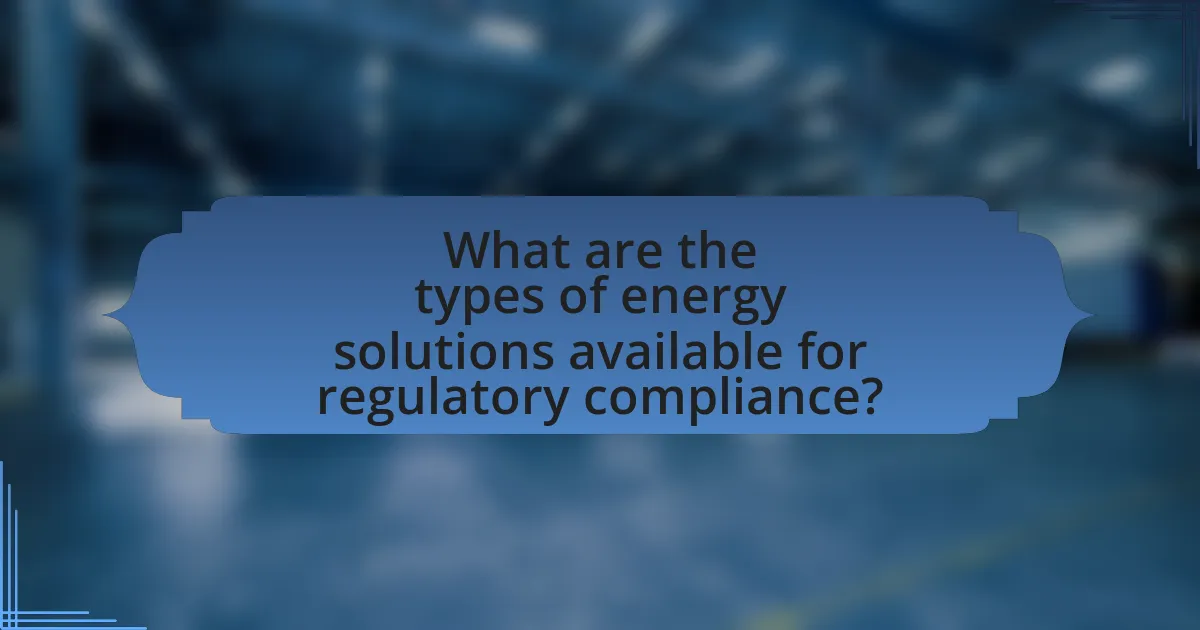
The types of energy solutions available for regulatory compliance include renewable energy sources, energy efficiency technologies, and energy management systems. Renewable energy sources, such as solar, wind, and biomass, help organizations meet emissions reduction targets mandated by regulations. Energy efficiency technologies, including advanced lighting, HVAC systems, and insulation, reduce energy consumption and lower operational costs while complying with energy standards. Energy management systems enable real-time monitoring and optimization of energy use, ensuring adherence to regulatory requirements. These solutions collectively support industries in achieving compliance with environmental regulations and sustainability goals.
What are the most common energy solutions used in the industrial sector?
The most common energy solutions used in the industrial sector include natural gas, electricity, renewable energy sources, and energy efficiency technologies. Natural gas is widely utilized due to its cost-effectiveness and lower emissions compared to coal. Electricity powers various industrial processes and machinery, while renewable energy sources, such as solar and wind, are increasingly adopted to meet sustainability goals and regulatory requirements. Energy efficiency technologies, including advanced manufacturing processes and equipment upgrades, help reduce energy consumption and comply with energy regulations. According to the U.S. Energy Information Administration, natural gas accounted for about 36% of the industrial sector’s energy consumption in 2020, highlighting its prevalence.
How do renewable energy sources fit into regulatory compliance?
Renewable energy sources fit into regulatory compliance by adhering to established environmental standards and regulations that promote sustainable energy practices. These sources, such as solar, wind, and hydroelectric power, often qualify for incentives and credits under regulations like the Renewable Portfolio Standards (RPS) and the Clean Power Plan, which aim to reduce greenhouse gas emissions and encourage the transition to cleaner energy. Compliance with these regulations not only helps industries meet legal requirements but also enhances their reputation and competitiveness in a market increasingly focused on sustainability.
What are the benefits of energy efficiency technologies?
Energy efficiency technologies provide significant benefits, including reduced energy consumption, lower operational costs, and decreased greenhouse gas emissions. These technologies enable industries to optimize their energy use, leading to savings on utility bills; for instance, implementing energy-efficient lighting can reduce energy use by up to 75%. Additionally, energy efficiency improvements can enhance equipment lifespan and reliability, further contributing to cost savings. According to the U.S. Department of Energy, energy efficiency measures can lead to a 20-30% reduction in energy use in industrial settings, demonstrating their effectiveness in promoting sustainability and compliance with regulatory standards.
How do energy management systems support compliance efforts?
Energy management systems (EMS) support compliance efforts by providing tools for monitoring, reporting, and optimizing energy usage in accordance with regulatory standards. These systems enable organizations to track energy consumption data, ensuring adherence to environmental regulations and energy efficiency mandates. For instance, EMS can automate the collection of energy data required for compliance reporting, reducing the risk of human error and ensuring timely submissions. Additionally, by analyzing energy usage patterns, EMS can identify areas for improvement, helping organizations meet specific regulatory targets, such as those set by the Energy Policy Act or local energy efficiency programs. This proactive approach not only aids in compliance but also enhances overall operational efficiency.
What features should an effective energy management system have?
An effective energy management system should have features such as real-time monitoring, data analytics, automated reporting, and integration capabilities. Real-time monitoring allows organizations to track energy consumption continuously, enabling immediate identification of inefficiencies. Data analytics provides insights into usage patterns, helping to optimize energy consumption and reduce costs. Automated reporting simplifies compliance with regulatory requirements by generating necessary documentation efficiently. Integration capabilities ensure that the energy management system can work seamlessly with existing infrastructure and other management systems, enhancing overall operational efficiency. These features collectively contribute to improved energy efficiency and regulatory compliance in the industrial sector.
How can data analytics improve compliance in energy solutions?
Data analytics can improve compliance in energy solutions by enabling organizations to monitor, analyze, and report on their energy usage and emissions in real-time. This capability allows companies to identify non-compliance issues promptly, ensuring adherence to regulatory standards such as the Clean Air Act and the Energy Policy Act. For instance, a study by the International Energy Agency found that companies utilizing data analytics for energy management achieved a 10-15% reduction in energy consumption, which directly correlates with improved compliance rates. By leveraging predictive analytics, organizations can also forecast potential compliance risks and implement proactive measures, thereby enhancing overall regulatory adherence in the industrial sector.
What best practices should industries follow for regulatory compliance in energy solutions?
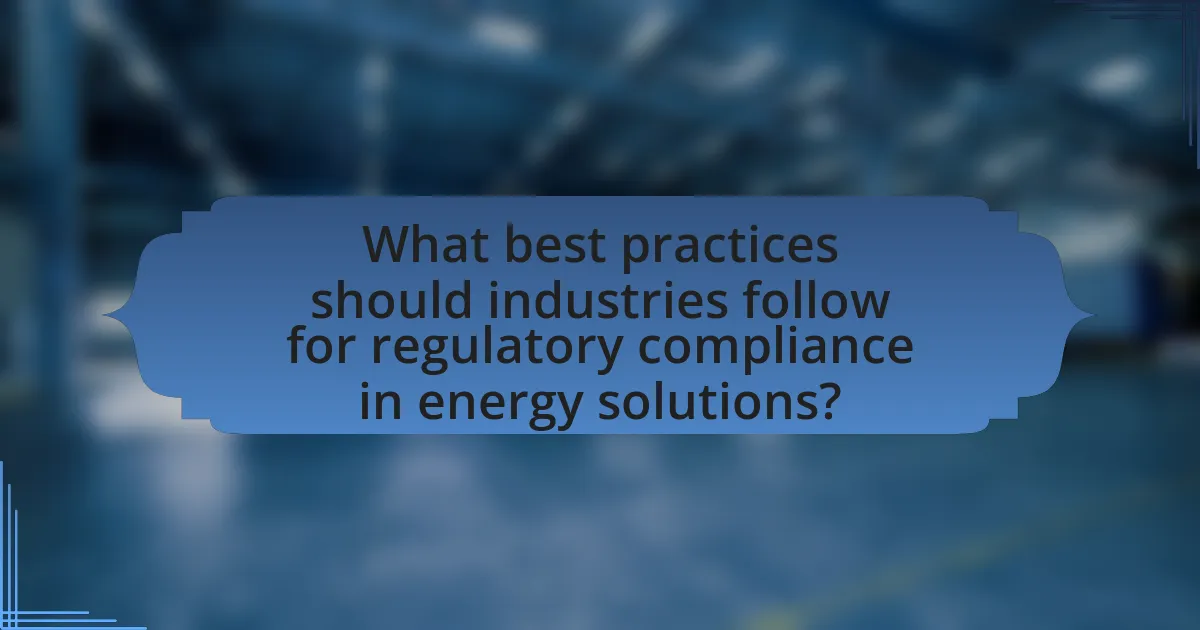
Industries should implement a comprehensive compliance management system to ensure regulatory compliance in energy solutions. This system should include regular audits, employee training, and adherence to local, national, and international regulations such as the Clean Air Act and the Energy Policy Act. Regular audits help identify compliance gaps, while employee training ensures that staff are aware of regulatory requirements and best practices. Furthermore, industries should maintain accurate documentation and reporting practices to demonstrate compliance to regulatory bodies, as evidenced by the Environmental Protection Agency’s guidelines which emphasize the importance of transparency and accountability in energy management.
How can industries develop a compliance strategy for energy solutions?
Industries can develop a compliance strategy for energy solutions by conducting a thorough assessment of relevant regulations and standards, such as the Energy Policy Act and ISO 50001. This assessment helps identify specific compliance requirements applicable to their operations. Following this, industries should implement a systematic approach that includes establishing clear policies, assigning responsibilities, and integrating compliance into their energy management systems. Regular training and awareness programs for employees are essential to ensure adherence to these policies. Additionally, industries should establish monitoring and reporting mechanisms to track compliance and make necessary adjustments based on regulatory changes or performance evaluations. This structured approach is validated by the fact that organizations with robust compliance strategies often experience reduced risks of penalties and improved operational efficiencies.
What steps should be taken to ensure ongoing compliance?
To ensure ongoing compliance in the industrial sector, organizations should implement a systematic compliance management program. This program should include regular audits to assess adherence to regulations, continuous training for employees on compliance requirements, and the establishment of clear policies and procedures that align with regulatory standards. Additionally, organizations must stay updated on changes in regulations and industry standards to adapt their practices accordingly. Evidence shows that companies with robust compliance programs experience fewer regulatory violations and penalties, highlighting the importance of proactive compliance measures.
How can training and education improve compliance outcomes?
Training and education can significantly improve compliance outcomes by enhancing employees’ understanding of regulatory requirements and best practices. When employees are well-informed, they are more likely to adhere to compliance protocols, reducing the risk of violations. Research shows that organizations with comprehensive training programs experience a 50% reduction in compliance-related incidents. Furthermore, ongoing education fosters a culture of accountability and vigilance, ensuring that employees remain updated on evolving regulations. This proactive approach not only mitigates risks but also promotes operational efficiency and sustainability within the industrial sector.
What are the future trends in regulatory compliance and energy solutions?
Future trends in regulatory compliance and energy solutions include increased integration of digital technologies, such as artificial intelligence and blockchain, to enhance transparency and efficiency in compliance processes. Regulatory bodies are focusing on stricter emissions standards and sustainability mandates, pushing industries to adopt cleaner energy sources and improve energy efficiency. For instance, the International Energy Agency reported that global energy-related CO2 emissions must decline by 70% by 2050 to meet climate goals, driving industries to innovate in energy solutions. Additionally, companies are increasingly adopting comprehensive compliance management systems that leverage real-time data analytics to ensure adherence to evolving regulations.
How is the regulatory landscape evolving for energy solutions?
The regulatory landscape for energy solutions is evolving towards stricter emissions standards and increased support for renewable energy sources. Governments worldwide are implementing policies that promote sustainability, such as the European Union’s Green Deal, which aims to make Europe climate-neutral by 2050, and the U.S. Inflation Reduction Act, which incentivizes clean energy investments. These regulations are designed to reduce greenhouse gas emissions and encourage the adoption of technologies like solar, wind, and energy storage systems. Additionally, regulatory frameworks are increasingly incorporating carbon pricing mechanisms, which further drive the transition to cleaner energy solutions.
What innovations are shaping the future of energy compliance in the industrial sector?
Innovations shaping the future of energy compliance in the industrial sector include advanced data analytics, real-time monitoring systems, and artificial intelligence. Advanced data analytics enables companies to assess energy consumption patterns and identify inefficiencies, leading to better compliance with regulations. Real-time monitoring systems provide continuous oversight of energy usage, allowing for immediate adjustments to meet compliance standards. Artificial intelligence enhances predictive maintenance and optimizes energy management strategies, ensuring adherence to regulatory requirements. These innovations collectively improve operational efficiency and reduce the risk of non-compliance, as evidenced by studies showing that companies implementing these technologies have achieved up to a 30% reduction in energy costs while maintaining compliance with energy regulations.
What practical tips can industries implement for effective regulatory compliance in energy solutions?
Industries can implement several practical tips for effective regulatory compliance in energy solutions, including establishing a comprehensive compliance management system. This system should involve regular audits to assess adherence to regulations, training programs for employees to understand compliance requirements, and the integration of technology for real-time monitoring of energy usage and emissions. For instance, the U.S. Environmental Protection Agency (EPA) emphasizes the importance of continuous monitoring and reporting to ensure compliance with the Clean Air Act, which can serve as a model for industries to follow. Additionally, engaging with regulatory bodies and industry associations can provide valuable insights and updates on changing regulations, ensuring that companies remain informed and proactive in their compliance efforts.
